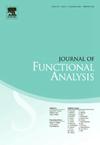基于积分恒等式的p- laplace的一个定量gidas - ni - nirenberg型结果
IF 1.6
2区 数学
Q1 MATHEMATICS
引用次数: 0
摘要
我们证明了涉及p-拉普拉斯算子的gidas - ni - nirenberg型对称结果的一个定量版本。本文通过积分恒等式实现了定量稳定性,该恒等式基于J. Serra(2013)建立的刚性证明,并将P.-L提出的论证扩展到一般维数和p-拉普拉斯算子。经典拉普拉斯函数中的二维狮子。Rosset(1994年)和Ciraolo, Cozzi, Perugini, Pollastro(2024年)通过移动平面的方法建立了经典Gidas-Ni-Nirenberg对称定理(涉及经典拉普拉斯算子)的稳定性结果。据作者所知,本文给出了p≠2时包含p-拉普拉斯算子的第一个定量gidas - ni - nirenberg型结果。即使对于经典拉普拉斯方程(即对于p=2),这也是第一次使用积分恒等式来实现gidas - ni - nirenberg型结果的稳定性。同时,我们得到了奇异集测度的一个定量估计和一个显式的一致梯度界。本文章由计算机程序翻译,如有差异,请以英文原文为准。
A quantitative Gidas-Ni-Nirenberg-type result for the p-Laplacian via integral identities
We prove a quantitative version of a Gidas-Ni-Nirenberg-type symmetry result involving the p-Laplacian.
Quantitative stability is achieved here via integral identities based on the proof of rigidity established by J. Serra in 2013, which extended to general dimension and the p-Laplacian operator an argument proposed by P.-L. Lions in dimension 2 for the classical Laplacian.
Stability results for the classical Gidas-Ni-Nirenberg symmetry theorem (involving the classical Laplacian) via the method of moving planes were established by Rosset in 1994 and by Ciraolo, Cozzi, Perugini, Pollastro in 2024.
To the authors' knowledge, the present paper provides the first quantitative Gidas-Ni-Nirenberg-type result involving the p-Laplacian for . Even for the classical Laplacian (i.e., for ), this is the first time that integral identities are used to achieve stability for a Gidas-Ni-Nirenberg-type result.
In passing, we obtain a quantitative estimate for the measure of the singular set and an explicit uniform gradient bound.
求助全文
通过发布文献求助,成功后即可免费获取论文全文。
去求助
来源期刊
CiteScore
3.20
自引率
5.90%
发文量
271
审稿时长
7.5 months
期刊介绍:
The Journal of Functional Analysis presents original research papers in all scientific disciplines in which modern functional analysis plays a basic role. Articles by scientists in a variety of interdisciplinary areas are published.
Research Areas Include:
• Significant applications of functional analysis, including those to other areas of mathematics
• New developments in functional analysis
• Contributions to important problems in and challenges to functional analysis

 求助内容:
求助内容: 应助结果提醒方式:
应助结果提醒方式:


